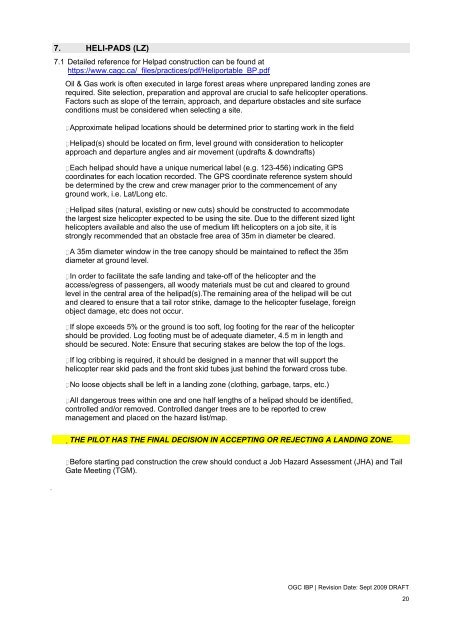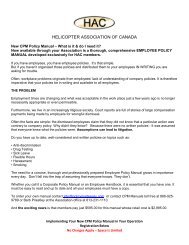6.3.4 Staging and Camp lighting6.3.4.1 Adequate lighting should be provided at the helipad and helicopter parking areas to allowinspection, preparation and loading <strong>of</strong> the helicopter in the hours <strong>of</strong> darkness. Subject to thesecurity risk assessment for the area, peripheral security lighting should be considered andplaced in a way that people approaching the aircraft will be clearly visible from a distance.6.3.4.2 The provision <strong>of</strong> helipad aviation lighting will depend on the decision by Company'smanagement on the requirement for a night evacuation capability from the base camp; normalflying operations will invariably take place only by day under Visual Flight Rules (DAY/VFR). Itis emphasized that a night capability should never be assumed in the seismic environment.6.4. Communications and navigation beacons6.4.1. The minimum requirement is for duplicated equipment to ensure that helicopters, whenairborne, are never out <strong>of</strong> contact with either the base camp or the local Air Traffic Controlnetwork. In many areas <strong>of</strong> the world, where such a network is basic, if it exists at all, theonus will be either <strong>of</strong> the Parties to provide appropriate coverage.6.4.2. For logistic and local advisory information VHF (air band) base equipment is appropriate and,provided the area can be covered by line <strong>of</strong> sight propagation; the alternate set may also beVHF. If, however, continuous cover cannot be guaranteed then a VHF Repeater maybe aviable option Satellite voice communication, if provided by the flight tracking system can alsoserve as alternate communication system6.4.3. A designated radio frequency should be assigned to the helicopter and ground crew for flightoperations.6.4.4. In remote areas, a third method <strong>of</strong> communication needs to be considered for use in theevent <strong>of</strong> an emergency, e.g. satellite telephone, in particular if the other communicationsystems may not provide contact if the aircraft is on the ground. In this case a “Dial in”system may be acceptable, although preference should be given to systems requiring aminimum <strong>of</strong> action and know how to be used.6.5. Accommodation6.5.1 Operations <strong>of</strong>ficeAn operations trailer is recommended for programs. Shelf space for Operations and Flight Manualsshould be available. A quiet rest area for Flight crew, with reasonably comfortable seating, should alsobe provided;6.5.2 Maintenance facilities and workshopsTechnical support facilities are essential. Maintenance at base camps will normally be restricted to linemaintenance with major inspections carried out at the <strong>Helicopter</strong> Provider’s main base. As part <strong>of</strong> thecontract award process the line-support facility requirements are to be detailed. It will, however, benecessary to provide the following as a minimum:-1. A secure store for aircraft spare parts, complete with rack and bin facilities, appropriate to thenumbers <strong>of</strong> aircraft on site. This may require air-conditioning, depending on which spares andconsumables will be stored on site.2. A secure and firepro<strong>of</strong> storage for oils, greases and flammable liquids.6.5.3 Sleeping QuartersTo comply with recognized Flight Time Limitation maxima and to avoid the hazard represented by shorttermfatigue, Flight crew sleeping accommodation must be quiet and comfortable, furnished to areasonable standard, well ventilated with climate control and with the facility to control levels <strong>of</strong> light.Single accommodation must be provided for Flight crews.Engineering personnel will be required to work unusual hours and their accommodation should also beequally and suitably appointed and separate from other groups.OGC <strong>IBP</strong> | Revision Date: Sept 2009 DRAFT19
7. HELI-PADS (LZ)7.1 Detailed reference for Helpad construction can be found athttps://www.cagc.ca/_files/practices/pdf/Heliportable_BP.pdf<strong>Oil</strong> & <strong>Gas</strong> work is <strong>of</strong>ten executed in large forest areas where unprepared landing zones arerequired. Site selection, preparation and approval are crucial to safe helicopter operations.Factors such as slope <strong>of</strong> the terrain, approach, and departure obstacles and site surfaceconditions must be considered when selecting a site.Approximate helipad locations should be determined prior to starting work in the fieldHelipad(s) should be located on firm, level ground with consideration to helicopterapproach and departure angles and air movement (updrafts & downdrafts)Each helipad should have a unique numerical label (e.g. 123-456) indicating GPScoordinates for each location recorded. The GPS coordinate reference system shouldbe determined by the crew and crew manager prior to the commencement <strong>of</strong> anyground work, i.e. Lat/Long etc.Helipad sites (natural, existing or new cuts) should be constructed to accommodatethe largest size helicopter expected to be using the site. Due to the different sized lighthelicopters available and also the use <strong>of</strong> medium lift helicopters on a job site, it isstrongly recommended that an obstacle free area <strong>of</strong> 35m in diameter be cleared.A 35m diameter window in the tree canopy should be maintained to reflect the 35mdiameter at ground level.In order to facilitate the safe landing and take-<strong>of</strong>f <strong>of</strong> the helicopter and theaccess/egress <strong>of</strong> passengers, all woody materials must be cut and cleared to groundlevel in the central area <strong>of</strong> the helipad(s).The remaining area <strong>of</strong> the helipad will be cutand cleared to ensure that a tail rotor strike, damage to the helicopter fuselage, foreignobject damage, etc does not occur.If slope exceeds 5% or the ground is too s<strong>of</strong>t, log footing for the rear <strong>of</strong> the helicoptershould be provided. Log footing must be <strong>of</strong> adequate diameter, 4.5 m in length andshould be secured. Note: Ensure that securing stakes are below the top <strong>of</strong> the logs.If log cribbing is required, it should be designed in a manner that will support thehelicopter rear skid pads and the front skid tubes just behind the forward cross tube.No loose objects shall be left in a landing zone (clothing, garbage, tarps, etc.)All dangerous trees within one and one half lengths <strong>of</strong> a helipad should be identified,controlled and/or removed. Controlled danger trees are to be reported to crewmanagement and placed on the hazard list/map.THE PILOT HAS THE FINAL DECISION IN ACCEPTING OR REJECTING A LANDING ZONE.Before starting pad construction the crew should conduct a Job Hazard Assessment (JHA) and TailGate Meeting (TGM).OGC <strong>IBP</strong> | Revision Date: Sept 2009 DRAFT20









